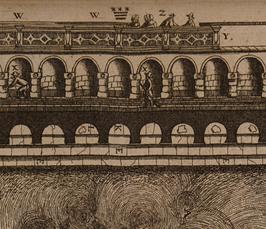Visualizing Physiology: Hygiene and Representation in 18th Century Europe
Research Seminar
- Online event via Zoom and on site (previous registration)
- Data: 28.04.2022
- Ora: 14:00 - 16:00
- Relatore: Maria Conforti, Karen Harvey, Giacomo Savani
- Luogo: Villino Stroganoff, Via Gregoriana 22, 00187 Roma & Zoom
- Contatto: boehm@biblhertz.it

The panelists will discuss social and artistic developments across Italy, England, and beyond to analyse the emergence of the modern notion of hygiene in the 18th century. In particular, comparing images and texts related to bathing practices and balneological theory will draw together approaches from the fields of cultural history, classical archaeology, history of medicine, and art history. Such a focal point will help engage methodologically with different kinds of visualising techniques through which 18th-century concepts of human physiology, hygiene, and self care were made sense of across different social status, occupation, life-stage, and religion.
1. Maria Conforti: Waters, fires and medicine: images of
balneology in Southern Italy
At the end of the 17th century, the
century-old tradition of balneology in the volcanic area of the
Phlegraean Fields and the nearby island of Ischia was revived, helping
foster a new image of the body and its processes. The connection between the
human body and the environment had been extremely important for the Hippocratic
tradition; it remained crucial for the ‘modern’ physiology, centering on
chemistry and mechanistic approaches to the body. The rich tradition of
painting and drawing in the city of Naples in the Baroque and early 18th
century intersected scientific approaches, producing a rich wealth of
images that will be used for this talk.
Maria Conforti is Associate Professor of history of medicine at the University of Rome. Her research interests focus on early modern Italy, with a special interest in scientific communication (academies, learned journals) and medical practice (surgery, anatomy).
2. Karen Harvey: "I am just going to Bathe": Washing, Water and the Body in
eighteenth-century British Letters
The history of dirt and filth in the early modern period is
well-established. Yet the most recent scholarship in the social history of
hygiene or cleanliness confirms that eighteenth-century men and women –
including the poor – adopted a range of techniques. Clothing and water were
dominant, linen and skin the two main objects. Evidence has come from a range
of sources, including ego documents, court records and material culture. This
paper examines the discussion of strategies for cleanliness in familiar letters
by ‘ordinary’ men and women. It explores the apparent purposes of these
strategies, such as disease-prevention, and what these tell us about how
eighteenth-century men and women envisioned their bodies.
Karen Harvey is Professor of Cultural History at the University of Birmingham and runs the Leverhulme project ‘Material Identities, Social Bodies: Embodiment in British Letters, c1680-1820'. Her latest book is The Imposteress Rabbit Breeder: Mary Toft and Eighteenth-Century England (2020)
3. Giacomo Savani: A Disputed Past: Ancient Balneology in Late-Stuart England
This talk addresses the reception of ancient medicine in late-Stuart
England, focusing on two central figures in the contemporary balneological
debate: John Floyer (1649–1734), a supporter of the healing virtues of cold
bathing, and Thomas Guidott (1638–1706), who championed the benefits of the hot
springs at Bath. Baths were recognised as essential in the healthy routine of
the ancients and prescribed for all sorts of ailments. Ancient practices
greatly influenced Floyer and Guidott, and their treatises abound with
references to Hippocrates and Galen, but also Tacitus and Suetonius. The
accuracy of these historical digressions was crucial to legitimising their
medical claims. Moreover, these authors offered different interpretations of
the past to push moral and religious agendas or glorify the antiquity of a
practice. By looking at the way they engaged with ancient sources, the paper
aims to reveal the role played by the past in the construction of contemporary
medical discourse.
Giacomo Savani is a RSE Saltire Early Career Fellow at the School of
Classics, University of St Andrews. He is currently investigating the reception
of ancient balneology and the role of images in scientific publications in Early
Modern Europe.
Please find the video registration of the event on our VIMEO CHANNEL: https://vimeo.com/manage/videos/704552380
SCIENTIFIC ORGANIZATION: Aleksander Musial. Event co-hosted by Visualizing Science Research Group and Art & Archaeology Department, Princeton University
Image: Anonymous, The King’s and Queen’s Baths at Bath, 1691, engraving in Thomas Guidott, De thermis Britannicis tractatus, London, 1691, plate 1. Copyright owner: Creative Commons (photo: Wellcome Library).